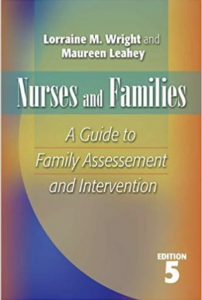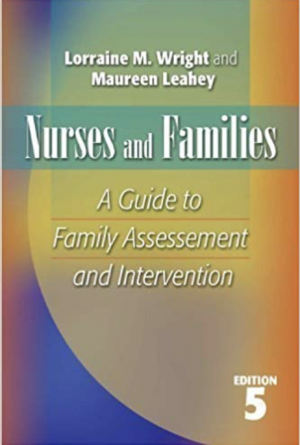Greetings and thanks for dropping by to read this blog. I appreciate the invitation by Dr. Janice M. Bell to write a guest blog about the Calgary Family Assessment Model.
 But where do I begin? Once upon a time….! Well, how about if I start by telling you how old the model is. In 2009, CFAM officially became 25 years old when the 5th Edition of Nurses and Families: A Guide to Family Assessment and Intervention was published by FA Davis in Philadelphia, PA. This book, co-authored by my good friend and colleague Dr. Maureen Leahey and me, has been the home of CFAM all these years.
But where do I begin? Once upon a time….! Well, how about if I start by telling you how old the model is. In 2009, CFAM officially became 25 years old when the 5th Edition of Nurses and Families: A Guide to Family Assessment and Intervention was published by FA Davis in Philadelphia, PA. This book, co-authored by my good friend and colleague Dr. Maureen Leahey and me, has been the home of CFAM all these years.
However, Maureen and I were teaching about the model for a few years prior to our book being published. Maureen and I met in the mid-1970’s and began offering workshops to practicing nurses in Calgary and Western Canada about working with families. Being young, ambitious and before the slick invention of powerpoint presentations, we would dutifully prepare numerous overheads and handouts for the participants about the model. As time passed, the handouts became thicker and thicker and the overheads more numerous. We have to thank those practicing nurses for encouraging us to publish a book about the model and for a chance encounter that I had with a book rep from FA Davis. When this rep asked about what books I might be interested in for my teaching, I instead offered the idea about writing a book for nurses about working with families. We already had an assessment model and some ideas for how to apply it in practice with families. This rep took the idea back to FA Davis and lo and behold a short time later, I received a call in my office from the Nursing Editor at FA Davis asking if I could put together a book proposal. And so our book Nurses and Families was born and first published in 1984 and CFAM was provided a permanent and long lasting home.
The nurses at our workshops and the nursing students that we taught gave us valuable feedback about the usefulness of the model and how they found it helpful in their practice. We incorporated those ideas into the model. Since the first publication in 1984 of the model within Nurses and Families, the model has undergone substantial embellishments in further editions in 1994, 2000, 2005, and 2009.
CFAM was initially an adaptation of an integrated and conceptual framework originally developed by Dr Karl Tomm and colleagues at the Family Therapy Program, University of Calgary (Tomm and Sanders, 1983). We adapted the original framework specifically for nurses to use when assessing families. We also gave it a name, the Calgary Family Assessment Model. We had tossed around many different names, even thinking of using our own names but thought that too cheeky, so we decided to simply name the model after the city where it evolved. Thus, it became the Calgary Family Assessment Model.
There are numerous family assessment models developed within various disciplines but Maureen and I are very gratified that CFAM was one of the four models identified in The Family Nurse: Frameworks for Practice monograph by the International Council of Nurses (Schober & Affara, 2001). The globalization of family nursing has resulted in our book and thus CFAM being translated into French, German, Japanese, Korean, Portugese, Icelandic and Swedish. We have also written and produced a DVD entitled Calgary Family Assessment Model: How to Apply in Clinical Practice (2001) which provided learners an opportunity to see the model implemented and applied with actual families.
Consequently, the model’s influence has traveled far and wide as family nursing has gone global. We are aware that CFAM is utilized in curricula throughout North America, Australia, Brazil, Chile, England, Finland, Germany, Hong Kong, Iceland, Japan, Korea, Qatar, Taiwan, Thailand, Portugal, Singapore, Scotland, Spain, and Sweden.
But what is a model? Is it a true assessment of a family? I prefer to think that models are useful because they bring phenomena into our awareness. It offers suggestions of what to observe and what to inquire about that could be useful in our understanding of a family.
However, it is important to always caution oneself that regardless of our conscientiousness, education, or expertise as a clinician, our assessment is still not the ‘truth’ about the family’s functioning related to a particular health problem or concern. Rather, the nurse and family members each have their own integrated assessment from their “observer perspective”. But nonetheless the assessment can be very useful for focusing the nurse and asking questions that relate to the various aspects of the model to gain a deeper understanding of the dynamics between illness and family functioning.
Some ask if the CFAM is for generalist or advanced practice? We think of the model as a template for working with families. Most often, CFAM is being used as a clinical practice model for generalist practice. However, as nurses become more skillful in their practice of caring for families, they will be able to expand their assessment questions to explore the various categories of the model. Also, they become more adept at knowing what categories are the most relevant to each particular family. As this happens, this could be considered advanced practice. The difference between generalist and advanced practice becomes the specificity and sophistication of being able to apply the model with increased competency and confidence.
We have also become aware that health professionals in other disciplines such as social work, psychology, family therapy, and medicine have found the CFAM model helpful. This is also very satisfying that CFAM is making a contribution in other disciplines.
Sometimes nurses using the model for the first time can become a bit overwhelmed because of their belief that all categories must be explored. But as they improve their conceptual skills, they quickly realize that the model needs to be adapted to each family. This begs the question if the CFAM needs to be condensed or to add more categories. This is a tricky aspect of any model and at the same time a subtle paradox. As our culture and society changes in terms of structure, functioning, and developmental issues, then we try to reflect these in the model. For example, in the early years of utilizing the model we did not have categories for Sexual Orientation or Religion/Spirituality in the branching diagram. But we do not want to expand the model with categories beyond those that are truly part of our evolving society or otherwise, it could become too cumbersome and not clinically useful.
Nurses beginning to use the model often find it useful to carry the CFAM branching diagram in their pocket and refer to it when meeting individuals/families. As nurses become more familiar with the model, then it is not necessary to carry a list of the categories but they find completing a genogram or family diagram for each individual or family to be second nature. Also second nature is to think of the developmental stage that the family is currently in and the tasks that are relevant. And perhaps the roles in one family are more important than the emotional communication in another family.
Are the categories of CFAM relevant to families across cultures? Again, the model needs to be adapted by nurses to make it useful to their particular culture. Overall, we find that the model can be applied and adapted to particular cultures. On a recent teaching experience in Doha, Qatar, the nursing students informed me that the Development Assessment did not easily fit their culture. Many Qatari families have 1-4 wives/mothers and many children. Therefore the task and attachments of the CFAM is not always a match for Qatari families. Therefore, I encouraged these bright Qatari nursing students to write their own Development category and send it to me so that we could include it in the 6th edition of Nurses and Families.
Applying models without knowledge about families will not enable nurses to adequately assess a family. Application of the model must be coupled with knowledge about families such as we offer about each category in the model as well statistics and trends found in Nurses and Families.
In closing, the most important aspect in the application of any model is that it must be within a relational practice. We nurses need to show sincere concern, compassion, and caring while asking even simple questions about family structure to more complex questions about the impact of an illness upon their family. So this concludes some aspects of the true story of the CFAM!!
 Lorraine M. Wright, RN, PhD
Lorraine M. Wright, RN, PhD
www.lorrainewright.com

